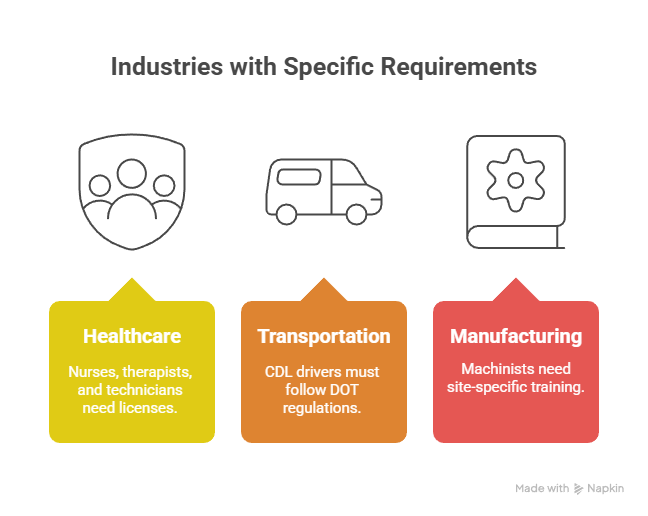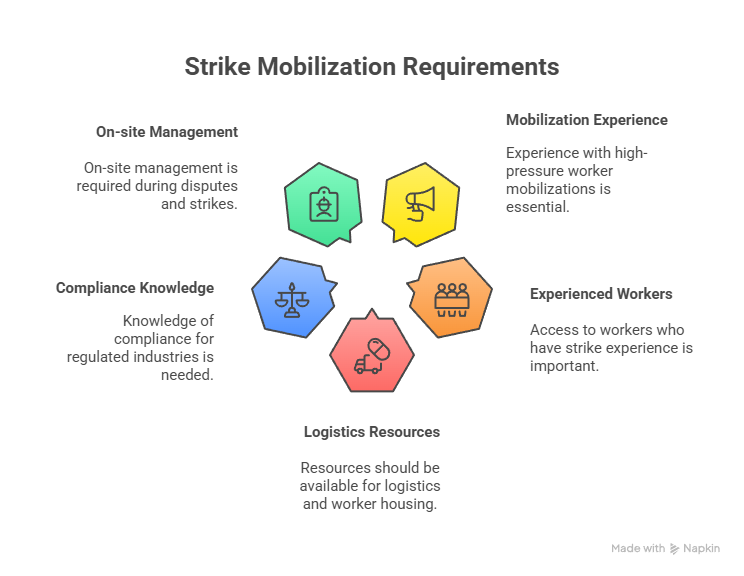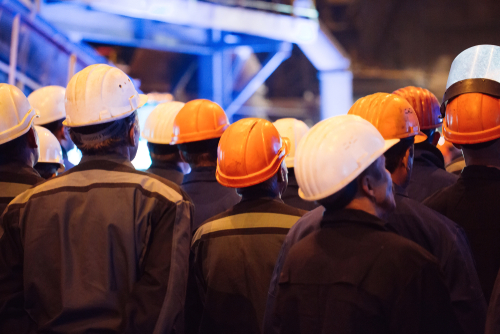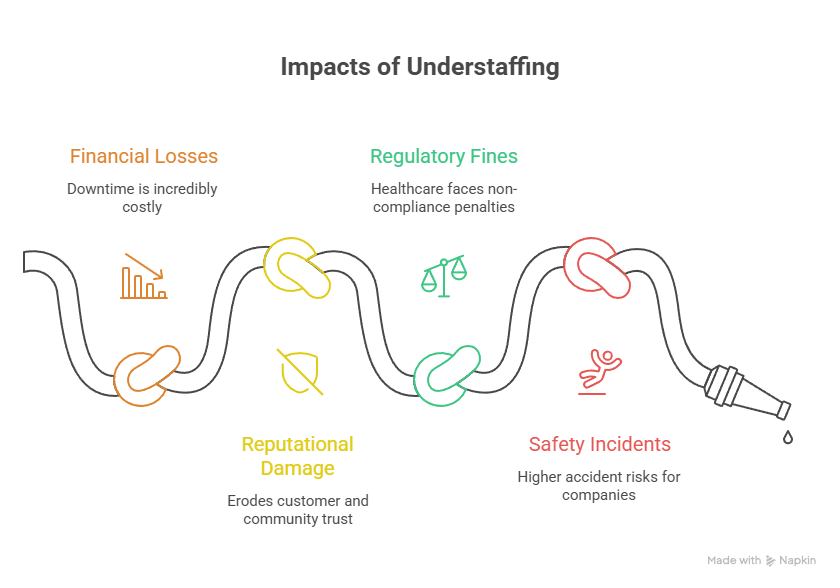
When a workforce stoppage suddenly halts operations, companies need answers fast. One of the most pressing questions leaders ask is: how quickly can a strike staff be deployed to keep business moving?
The answer depends on multiple factors—industry, location, workforce size, legal requirements, and preparation level—but with the right strike staffing partner, deployment can often happen in as little as 24 to 72 hours. For organizations in industries like healthcare, logistics, manufacturing, or utilities, that speed can make the difference between staying operational and suffering costly shutdowns.
Why Speed Matters in Strike Staffing
Strikes rarely happen at convenient times. They disrupt production schedules, customer service, supply chains, and patient care—often with little notice. Every hour of downtime translates into:
- Lost revenue from halted production or service delivery
- Damaged reputation with clients and communities
- Risk exposure in safety-critical environments like hospitals or energy plants
- Supply chain breakdowns that impact not just one company but entire networks
Fast deployment of strike staff is not just about filling shifts; it’s about maintaining business continuity and protecting critical functions.
Typical Deployment Timeframes
While timelines vary, most strike staffing deployments fall into these categories:
1. Rapid Deployment (24–72 Hours)
When a company has worked with a staffing partner in advance, strike replacement workers can often be on-site in one to three days. These scenarios usually involve:
- Pre-negotiated contracts with staffing agencies
- Active rosters of qualified, vetted workers
- Clear communication between management and the staffing partner
2. Standard Deployment (3–7 Days)
If an organization has not prepared ahead of time, it generally takes about three to seven days to bring in replacement staff. This window allows agencies to:
- Recruit from national pools of workers
- Handle background checks, licensing, and compliance
- Arrange travel and housing logistics
3. Complex Deployment (1–2 Weeks+)
For large-scale strikes, niche industries, or highly regulated environments (such as unionized healthcare systems or specialized energy facilities), staffing can take longer. Extra time is needed for:
- Industry-specific training
- Credential verification
- Onboarding for safety-critical roles
Factors That Influence Strike Staff Deployment Speed

1. Industry Type
Healthcare, energy, transportation, and manufacturing all have different requirements. For example:
- Healthcare: Nurses, respiratory therapists, and technicians often require state licenses and credentialing.
- Transportation & Logistics: CDL drivers must meet Department of Transportation regulations.
- Manufacturing: Skilled machinists or plant operators may need site-specific training.
2. Union Notification and Timing
Unions typically file strike notices (often 10 days in healthcare), which gives employers some lead time. However, not all industries have mandated notice periods—making proactive partnerships critical.
3. Geographic Location
Urban areas often have faster deployment due to proximity to airports, housing, and a larger pool of available workers. Remote or rural locations may require more logistical coordination.
4. Size of the Workforce
Replacing a handful of specialized roles can sometimes be faster than deploying hundreds of general workers. Large-scale mobilizations require transportation, housing, and coordination of multiple teams.
5. Staffing Partner Preparedness
The experience and resources of the staffing partner directly impact speed. Agencies with national networks, pre-qualified databases, and dedicated strike response teams can mobilize far quicker.
The Deployment Process Step by Step
Step 1: Initial Assessment
Once a potential strike is identified, the staffing partner evaluates:
- Number of positions needed
- Roles and skillsets required
- Timeline for deployment
- Geographic challenges
Step 2: Recruitment and Roster Activation
If the agency already has rosters of strike-experienced workers, calls go out immediately. Otherwise, recruitment begins across regional and national networks.
Step 3: Credentialing and Compliance
Workers are screened for background checks, certifications, and any regulatory requirements. In healthcare, this step includes state-by-state license verification.
Step 4: Logistics Coordination
Housing, travel, and meal arrangements are organized—often in hotels or short-term rentals near the worksite. Transportation to and from facilities is secured to avoid delays.
Step 5: On-Site Deployment
Strike replacement workers arrive at the site, are briefed, and assigned shifts. Staffing partners often provide on-site supervisors to ensure accountability and smooth transitions.
How Companies Can Accelerate Deployment
1. Establish a Strike Staffing Plan Before a Crisis
Pre-negotiated agreements with a strike staffing partner save valuable days. Companies that wait until a strike begins lose critical time to paperwork, contract reviews, and negotiations.
2. Maintain Clear Communication with Employees and Agencies
Timely updates from unions, HR teams, and executives allow staffing partners to anticipate needs rather than react at the last minute.
3. Prioritize Critical Roles
Not all positions may need replacement on day one. Identifying “mission-critical” roles helps focus resources where they matter most.
4. Use Agencies with Proven National Reach
Local firms may struggle with scale and speed. National agencies with transportation networks and pre-vetted candidates can often mobilize in days, not weeks.
5. Prepare Housing and Security in Advance
Especially for high-tension strike environments, ensuring safe accommodations and secure worksites is essential to keeping replacement staff operational.
Risks of Delayed Deployment
Every day without replacement staff compounds costs:
- Financial Losses: Manufacturing downtime can cost tens of thousands per hour.
- Reputational Damage: Customers and communities lose confidence in a company that cannot deliver.
- Regulatory Fines: Healthcare facilities risk non-compliance penalties if patient staffing ratios are not maintained.
- Safety Incidents: Energy, utility, and transportation companies face higher accident risks when understaffed.
Beyond Speed: Factors That Shape Effective Strike Deployment
While speed is the headline, it’s not the only measure of a successful strike staffing response. The quality of the deployment—how well workers are trained, housed, and integrated—matters just as much. Below, we’ll explore often-overlooked aspects that make the difference between simply “getting people in the door” and actually sustaining productivity under pressure.
The Logistics Backbone of Strike Deployment
Fast deployment isn’t possible without logistics running smoothly in the background.
- Transportation Coordination: Strike staff often travel across state lines. Coordinating flights, ground transport, and shuttles is the difference between being ready on day one or losing precious hours.
- Housing Management: Agencies typically secure blocks of hotel rooms or short-term rentals. Housing has to be close enough to minimize commute time but also secure to avoid tension with striking workers.
- Shift Transitions: In tense strike environments, controlled entry and exit procedures keep replacement workers safe and punctual. Pre-planned logistics help reduce delays during shift changes.
Without these systems, even a fast roster activation can crumble under logistical bottlenecks.
Training and Onboarding Strike Staff Quickly
Strike workers are often stepping into unfamiliar facilities. Even if they are seasoned professionals, they need rapid orientation to your unique workflows.
- Site-Specific Training: OSHA standards, PPE use, and machine safety vary widely by facility. Agencies often deliver accelerated orientation sessions to bring new workers up to speed.
- Role-Based Training: Critical positions—such as nurses handling specialized equipment or drivers using specific fleet technologies—require focused onboarding to ensure compliance.
- On-Site Supervision: Having strike supervisors embedded with teams ensures replacement staff can ask questions and adapt quickly. This oversight is especially vital in regulated industries like healthcare or aviation.
When onboarding is done well, strike staff are not just present—they are productive.
How Technology Speeds Up Deployment
Technology has shortened deployment timelines across industries:
- Digital Credentialing Systems: Electronic verification of licenses and certifications can cut days off the process.
- AI-Driven Roster Management: Agencies increasingly use software that instantly matches available workers with open positions, factoring in location, licensing, and prior strike experience.
- Mobile Apps for Communication: Workers receive updates, shift schedules, and facility instructions in real time, reducing confusion and miscommunication.
A staffing partner that embraces technology can often outpace competitors who rely solely on manual processes.
Industry-Specific Deployment Challenges
Each industry has nuances that influence how quickly staff can be deployed.
- Healthcare: Beyond licensing, patient safety regulations require strict adherence to ratios. Agencies must deploy both volume and compliance-ready professionals.
- Manufacturing: Worker familiarity with specialized machinery is critical. A short training delay can ripple into production backlogs.
- Energy & Utilities: Remote or hazardous environments extend deployment timelines. Workers must be trained in both technical skills and safety protocols.
- Transportation & Logistics: CDL drivers face Department of Transportation regulations, drug testing requirements, and logbook compliance. Quick mobilization requires streamlined credentialing.
Understanding these sector-specific factors helps companies set realistic expectations for deployment speed.
The Human Factor: Resilience and Professionalism
Deployment isn’t just about logistics—it’s about people. Strike staff often walk into high-tension environments where emotions run high. Their professionalism ensures continuity without escalating conflict.
- Experience Matters: Workers who have participated in prior strike deployments adapt faster to tense conditions.
- Resilience Training: Agencies often prepare staff for how to handle protests, picket lines, and challenging work environments with professionalism.
- Support Networks: Providing strike workers with meals, transport, and secure housing improves morale, which translates into better on-the-job performance.
The best staffing agencies focus not just on speed, but also on the human element of deployment.
Long-Term Benefits of Strike Staffing Preparedness
While strike staffing is often seen as a temporary solution, preparedness offers lasting value:
- Business Continuity Planning: Companies that partner with agencies early are better positioned to weather future disruptions.
- Operational Resilience: Even outside of strikes, the ability to quickly mobilize staff builds organizational strength.
- Reputation Protection: Clients, regulators, and communities notice when companies stay operational under pressure.
Preparedness signals reliability—and that can mean long-term trust and stability.
Why Partnering with a Strike Staffing Expert Matters
Strike staffing is not the same as general temp staffing. It requires:
- Experience with high-pressure mobilizations
- Access to strike-experienced workers
- Resources for logistics and housing
- Compliance knowledge for regulated industries
- On-site management during disputes
Working with a seasoned partner ensures not just speed of deployment but also quality and compliance.

FAQ: Strike Staffing Deployment Timelines by Location
How fast can strike staff be deployed in California?
In California, strike staffing can often be deployed within 72 hours, especially in healthcare settings where unions must provide a 10-day notice. Agencies with pre-vetted California-licensed professionals can act quickly.
How quickly can strike replacement workers be deployed in New York?
In New York, staffing partners typically mobilize within 3–5 days, though urban centers like NYC often see faster deployment due to a larger available workforce.
What is the average strike staffing timeline in Texas?
In Texas, replacement staff can usually be on-site within 2–4 days. Proximity to major airports and a strong logistics network often accelerate timelines.
How soon can strike staff be deployed in Illinois?
Illinois strike staffing typically takes 3–7 days, depending on industry. Chicago’s urban workforce availability can speed up deployment compared to rural areas.
How quickly can strike staff be deployed in Florida?
Strike staff in Florida are often on-site within 3–5 days, supported by strong transportation networks and proximity to major airports.
How fast can strike replacement workers mobilize in Pennsylvania?
In Pennsylvania, average deployment takes 3–7 days, though Philadelphia and Pittsburgh benefit from nearby staffing hubs that shorten timelines.
What is the strike staffing timeline in Ohio?
In Ohio, deployment typically occurs within 4–6 days. Access to skilled manufacturing and healthcare professionals can sometimes reduce this window.
How soon can strike staff arrive in Washington State?
Deployment in Washington often takes 5–7 days, with rural and coastal regions sometimes requiring additional logistics planning.
How fast can strike replacement workers be mobilized in Georgia?
In Georgia, replacement staff can generally be mobilized within 2–4 days, especially in Atlanta and surrounding metro areas with strong staffing networks.
How fast can strike staff be deployed in remote locations?
Remote or rural areas often require more logistics, so deployment may take 5–10 days, especially if specialized housing and transportation are needed.










